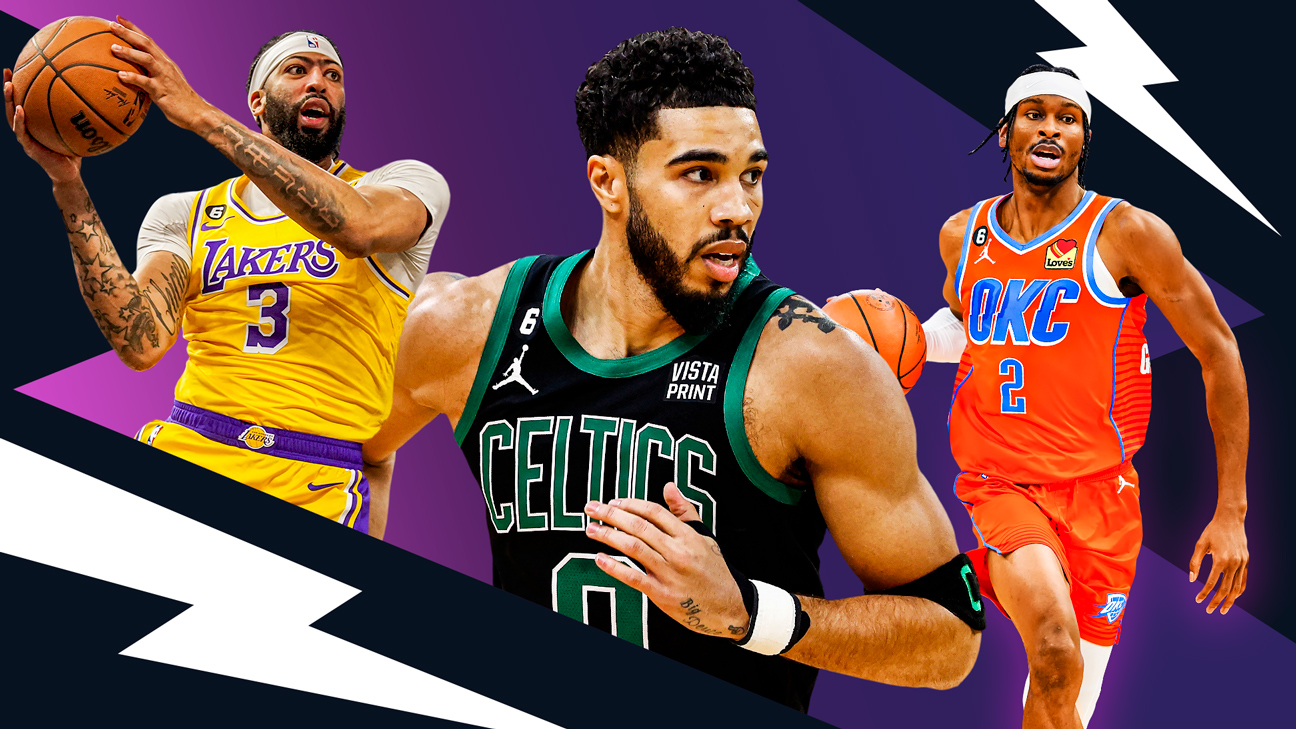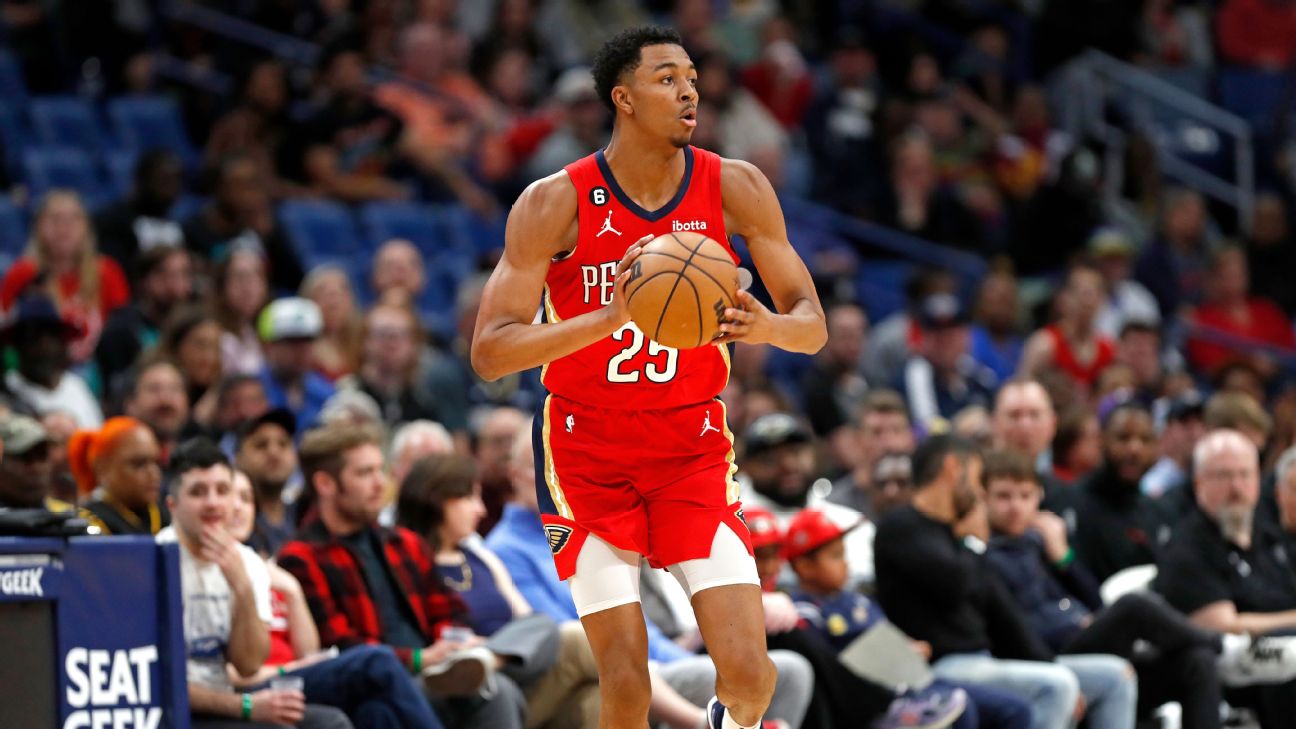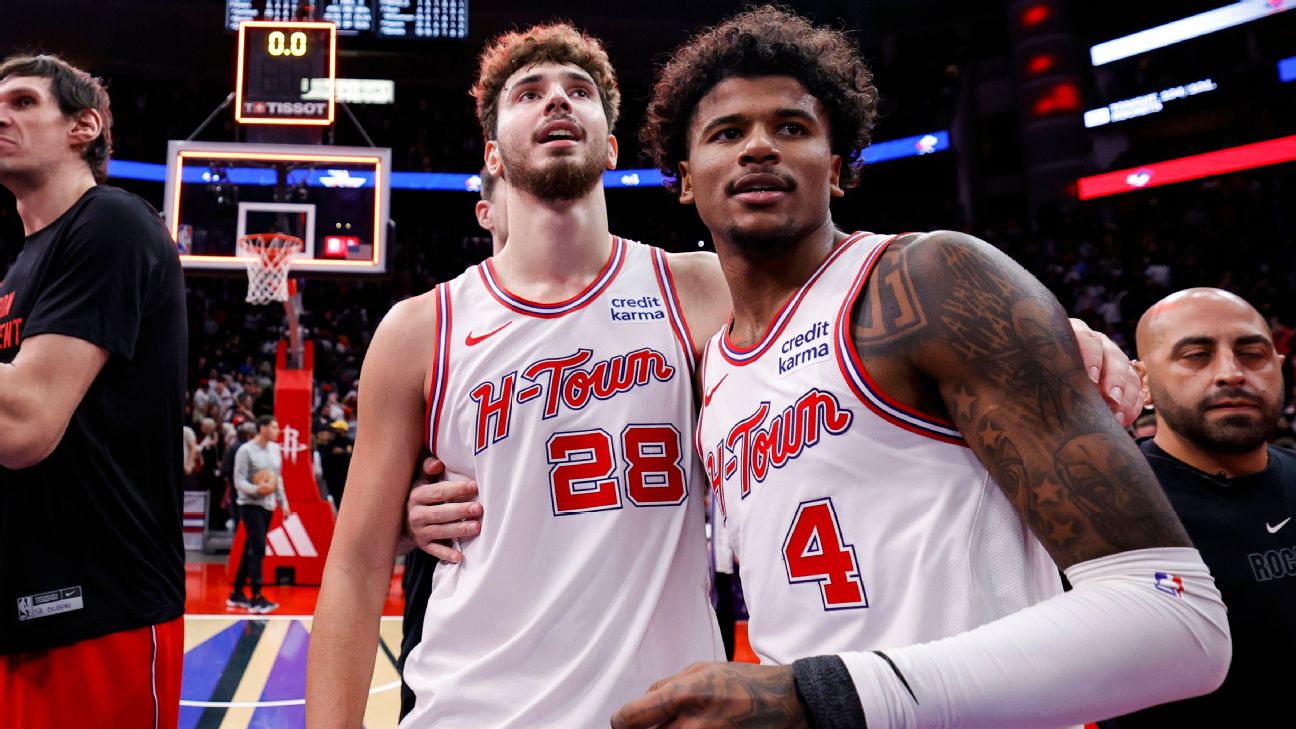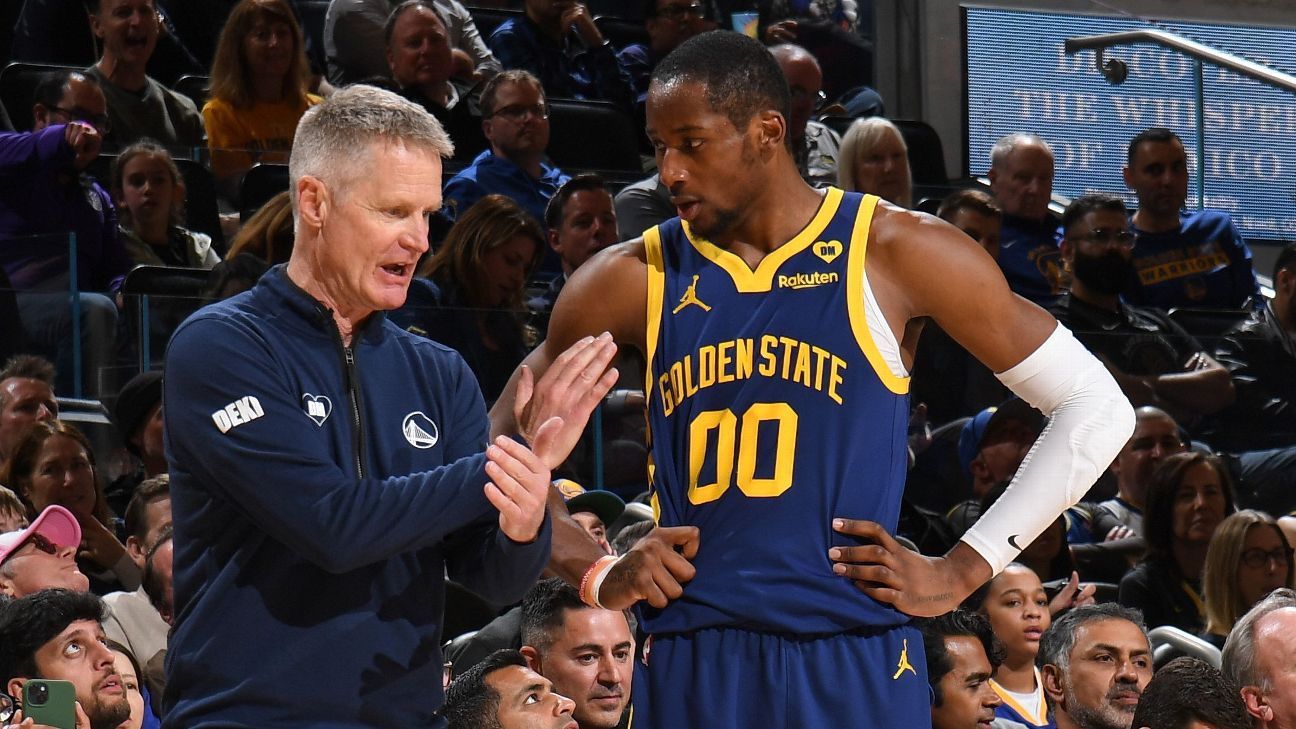Illustration by ESPN
How will your team perform over the next three NBA seasons?
The Future Power Rankings are ESPN’s projection of the on-court success expected for each team over the next three seasons: 2023-24, 2024-25 and 2025-26.
Consider this a convenient way to see the direction in which your favorite team is headed. To determine the Future Power Rankings, we asked ESPN analysts Kevin Pelton, Bobby Marks, Andre Snellings and Tim Bontemps to rate teams in five categories and rank them relative to the rest of the league.
Since the last version of the Future Power Rankings dropped at the start of last season, we’ve seen the Denver Nuggets claim their first NBA title. But was that enough to vault them to the top of our rankings? And what about the Utah Jazz, who were in the cellar last year but had a surprisingly strong start to their rebuild?
An explanation of each category and a full view of how each team did in each category is at the bottom of the rankings. Each team also received an overall Future Power Rating of 0 to 100, based on how well we expect it to perform over the next three seasons. Here are our latest rankings.
Note: The last version of these rankings was released in October 2022.
Despite ranking in the top three seven times in FPR, including No. 3 a year ago, this is the first time the Celtics have reached the top spot in the 14-year history of the exercise. Boston topped the field in the players category, outweighing the second-lowest score in future flexibility after Jaylen Brown signed a supermax extension and Jayson Tatum becomes eligible for one next summer. Eventually, the NBA’s new restrictions on tax-paying teams could break up the Celtics’ core, but not before multiple runs at bringing an 18th championship to Boston. — Kevin Pelton
(Previous rank: No. 3)
The NBA champions are built to have sustainable success for the foreseeable future and as a result move up seven slots in the FPR. Denver ranked No. 2 in players, as the starting five of MVP Nikola Jokic, Jamal Murray, Kentavious Caldwell-Pope, Michael Porter Jr. and Aaron Gordon are all under contract through at least 2024-25 (Caldwell-Pope has a player option and can be a free agent in 2024). The strong roster building, championship success last season and financial commitment by ownership explain why Denver ranks No. 3 in management.— Bobby Marks
(Previous rank: No. 9)
Jumping up 20 spots in these rankings from this time last season only magnifies the hype and anticipation surrounding this young Thunder squad, which ranked no lower than seventh in four of the five categories: players (seventh), money (sixth), management (second) and draft (first). A first-team All-NBA talent in Shai Gilgeous-Alexander is surrounded by emerging young talent like Jalen Williams, Chet Holmgren and Josh Giddey. Add in a bevy of future draft assets and cap space to play with and it should be a fun few years ahead for Sam Presti & Co. — Tim Bontemps
(Previous rank: No. 23)
The Grizzlies held the top spot in the FPR last season as a team full of young talent on affordable contracts with flexibility and upside to win championships moving forward. The off-court issues and subsequent suspensions of Ja Morant derailed their championship aspirations last season and will have to be overcome this season as well. Memphis still has some of the best talent in the league, but as contract extensions have kicked in the Grizzlies have less financial flexibility moving forward. This exacerbates the challenges of acquiring and maintaining impact players on a small-market team. They will look to the continued development and retention of their two Defensive Players of the Year in Jaren Jackson Jr. and newly acquired Marcus Smart in addition to second scoring option Desmond Bane to support Morant moving forward. All four are under contract for at least the next three seasons. — Andre’ Snellings
(Previous rank: No. 1)
The Warriors have been the gold standard for the past decade, the top-rated team in 2019 that has fallen out of the top 10 in only one FPR (2021) in the years since. Though their nucleus of Stephen Curry, Draymond Green and Klay Thompson is getting older, they were still strong enough to win a championship in 2022. That core, along with younger All-Star Andrew Wiggins and veteran addition Chris Paul, landed them with one of the higher player value scores in the league. The Warriors also play in an excellent market, and though Bob Myers moved on, new general manager Mike Dunleavy Jr. has been part of their strong management group for years. The future is a bit murkier, with two first-round and multiple second-round draft picks owed in upcoming years and the highest payroll in the NBA this season, but for the present the Warriors still seem to have what they need to continue to contend. — Snellings
(Previous rank: No. 4)
The Bucks have traded away their future draft picks and have contracts clogging their books for most of the rest of the decade. So why do they rank comfortably inside the top 10? Because they might have the NBA’s best one-two punch in Giannis Antetokounmpo and Damian Lillard, which helped them finish third in the player category, and rank inside the top 10 in management despite hiring a rookie coach in Adrian Griffin this offseason. That’s a nod to the work general manager Jon Horst has done over the past several years, including the Lillard trade this summer. — Bontemps
(Previous rank: No. 5)
The Heat rank No. 7 for a second straight season, largely in part to a management group led by president Pat Riley and coach Erik Spoelstra. Miami also ranks No. 3 in market, up three spots from last year. If there is a concern, it comes with a roster that falls one spot to No. 12. The Heat’s two foundational players, Jimmy Butler and Bam Adebayo, are under contract for the next three seasons. However, current and future financial restrictions will force the Heat to continually focus on player development, finding bargains in free agency and identifying undrafted players. — Marks
(Previous rank: No. 7)
This is just the second time in the past decade the Knicks have cracked the top 10, a testament to how they’ve mismanaged our second-ranked market. As compared to their last top-10 appearance in May 2021, during another run to the conference semifinals, this entry feels more sustainable. New York has collected future draft picks to add a disgruntled superstar via trade to a core built largely from within. That patient strategy along with Tom Thibodeau getting the most out of the roster lifted the Knicks’ management score nine spots. — Pelton
(Previous rank: No. 17)
Although the Suns moved up one spot, they’ve pushed their chips in as perhaps the most mortgaged team in the Stepien rule era of the NBA draft. Phoenix ranks 30th in that category after trading or swapping every possible first-round pick, some of them swapped multiple times. The Suns hope that the fourth-ranked roster they’ve built with those deals adding Bradley Beal and Kevin Durant can deliver the first title in franchise history. Whether that happens or not, this might be the highest Phoenix ranks in a while as the bill comes due in terms of picks and luxury tax. — Pelton
(Previous rank: No. 10)
For the first time since October 2021, the Lakers cracked the top 10 in the FPR. The six-spot jump from last ranking is a result of a roster transformation (the Lakers moved from No. 16 to No. 8 in the player category) led by general manager Rob Pelinka. Out of the 14 players from the roster that started the 2022-23 season, only four remain: LeBron James, Anthony Davis, Austin Reaves and Max Christie. Davis recently signed a three-year extension and is under contract through 2027-28, while Reaves has four years left on the deal he signed this summer. The unknown moving forward is what the future holds for James. He has a $51.4 million player option in 2024 and can become a free agent after this season. — Marks
(Previous rank: No. 16)
The Kings might have been the NBA’s best story last season. They finally broke through and returned to the playoffs for the first time since 2006, winning the Pacific Division before losing a heartbreaking seven-game series to their Bay Area rivals in the Golden State Warriors. Sacramento lands where it is on this list because of its consistency across the rankings: The Kings rank 14th in four of the five categories (players, draft, money, management), along with a 21st market rating (which is up six spots from last year — the power of The Beam). — Bontemps
(Previous rank: No. 26)
The Cavaliers have steadily climbed the rankings, from last place in 2020 and 2021 up to No. 12 this season. The lion’s share of their improvement has come with the impressive array of young player talent they have acquired, with Donovan Mitchell, Darius Garland and Jarrett Allen having already received All-Star nods. Evan Mobley is still only 22 years old in Year 3 after a first-team All-Rookie inaugural campaign. The Cavs play in a small market and have leveraged draft picks and money to assemble their talent, but they have been a well-run franchise in recent years with upside to move up this list if their young players take the next step and lead them to championship contention. — Snellings
(Previous rank: No. 12)
The 76ers are outside of the top 10 on this list for the first time since 2021 with the third-largest season-on-season drop in the NBA, down seven slots from last season. A big part of their lower score is lack of draft capital, with two first-round and three second-round picks owed from trades due in upcoming seasons. But the uncertainty surrounding the future of James Harden, who is in camp but very publicly unhappy and asking to be traded, also plays a part. Joel Embiid is the reigning NBA MVP and Tyrese Maxey appears to be a young star in the making, but the team’s decisions regarding the deployments of Harden and Tobias Harris, who is operating on a large, expiring contract, will play a large part in how the Sixers are evaluated in the next iteration of the FPR. — Snellings
(Previous rank: No. 6)
The fact the Clippers reside in Los Angeles and have a management group ranking sixth in the league means they can fall only so far down this list. But after years of spending plenty of Steve Ballmer’s money and trading away draft picks, rankings of 24th in both the money and draft categories have weighed down their rating. So, too, is the fact that the Clippers come in 17th in the players category. The uncertain futures of stars Kawhi Leonard and Paul George — both entering the final years of their contracts — make it hard to know what this team will look like as it enters the Intuit Dome next fall. — Bontemps
(Previous rank: No. 2)
What a difference a year makes. The Jazz recouped seven first-round picks and three pick swaps from the Donovan Mitchell and Rudy Gobert trades, but Utah still ranked last in the FPR. The reason? A roster that ranked last among teams and the unknown of then-rookie head coach Will Hardy. The Jazz’s roster moves up 10 slots thanks in part to the play of All-Star forward Lauri Markkanen and first-team All-Rookie selection Walker Kessler. The Jazz will likely not be a playoff contender this season but have the financial flexibility and draft assets to improve over the next three seasons. Utah ranked No. 3 in draft equity and No. 4 in money. The Jazz also cracked the top five in management, moving up nine slots from last year. — Marks
(Previous rank: No. 30)
Since vaulting to sixth in March 2020 during Luka Doncic’s breakthrough sophomore campaign, the Mavericks have been trending in the wrong direction. This is their lowest finish in the past five years. Last year’s drop proved justified when Dallas slipped out of the play-in race after making a risky trade to pair Kyrie Irving with Doncic. The Mavericks still rank just outside the top 10 in players, but they’ve largely tapped out their cap flexibility and continue to owe the Knicks a first-round pick to complete the Kristaps Porzingis trade. — Pelton
(Previous rank: No. 13)
The good news is the Pelicans still have extra picks coming from the Los Angeles Lakers and Milwaukee Bucks, which they can use to upgrade what already rates as a league-average roster. The trick, and why New Orleans fell six spots in the past year, is the financial challenges the Pelicans face as a team that has never paid the luxury tax with Zion Williamson’s rookie extension kicking in. Of course, nothing would help New Orleans’ future more than Williamson staying healthy for a full season and playing as strong as the two months we saw from him in 2022-23. — Pelton
(Previous rank: No. 11)
Call it the Victor Wembanyama effect. A year ago, the rebuilding Spurs rightfully ranked No. 28 in the FPR. After finishing with a 22-60 record last season but finding lottery luck with the top pick, San Antonio ranks No. 18, its highest ranking since October 2021. The retooling of the roster is far from finished even with a franchise player like Wembanyama on the roster. The Spurs project to have significant cap space over the next three seasons, a reason they rank No. 1 in money. In addition, San Antonio has 11 first-round picks and three pick swaps (Atlanta, Boston and Dallas) over the next seven years. — Marks
(Previous rank: No. 28)
After trading for Rudy Gobert and Mike Conley from Utah (in separate deals) and seeing the continued emergence of both Anthony Edwards and Jaden McDaniels, Minnesota clocks in at No. 11 in the player category. But rankings of 25th in money, 28th in the draft and 30th in market are enough to keep the Timberwolves out of the top half of the league. There is plenty of pressure in Minnesota to deliver success on the Gobert deal after expending so much future draft capital only to lose in the first round of the playoffs as an eighth seed last season. — Bontemps
(Previous rank: No. 15)
The Hawks have ranked in the middle of the road for the past several seasons, with an average FPR of 16.5, a high-water mark of No. 11 and a low of No. 22 since March 2019. This is their lowest ranking since March 2020, and it stems from a lack of any particular category of strength. The Hawks’ best ranking score came in market for the city of Atlanta, but their player caliber ranked in the lower half of the league at No. 18 — the same as their team’s ranking in win percentage in the league last season. They have a strong backcourt in Trae Young and Dejounte Murray but traded away John Collins this offseason, making their front line thinner and less explosive. The Hawks also owe more future first-round picks and swaps than they have coming in from trades, limiting their options to improve moving forward. — Snellings
(Previous rank: No. 14)
The Pacers improved by six slots in the rankings from last season, largely on the strength of their potential to improve in the future. The Pacers are owed a first-round pick and a net of three additional second-round picks in upcoming years, and they have the lowest payroll in the NBA with several large expiring contracts opening up more cap space in future seasons. Some of that cap space will be taken by a max extension for young All-Star point guard Tyrese Haliburton, but Indiana will still have young talent on rookie contracts in first-team All-Rookie selection Bennedict Mathurin and 2023 lottery pick Jarace Walker. — Snellings
(Previous rank: No. 27)
In many ways, the Nets have returned to where they were five years ago. Brooklyn ranked 18th in the 2018-19 preseason a year ahead of signing Kevin Durant and Kyrie Irving. Now with both stars having been traded away, the Nets are once again preparing to position themselves to be an option for other stars. The Nets ranked No. 11 in money and draft and No. 6 in market, which helps balance out lower rankings in management (19) and players (23). It also shows the Nets have the tools to potentially add talent to the roster quickly over the next couple of seasons, depending on how things shake out. — Bontemps
(Previous rank: No. 19)
The Magic improved their win total from 22 to 34 and have the roster resources to take another jump. Led by Rookie of the Year winner Paolo Banchero, Franz Wagner and Wendell Carter Jr., Orlando has a sustainable foundation in place. Banchero averaged 20.0 points this past season, the most by a rookie since Luka Doncic in 2018-19. He and Wagner are the third pair of teammates 21 or younger to average 18 points in a season. Because half the roster is players on first-round rookie-scale contracts, Orlando is poised to have significant cap flexibility in the next three seasons. The Magic also have 18 draft picks over the next seven years, including seven in the first round. — Marks
(Previous rank: No. 24)
This is the lowest Toronto has ranked since hiring Masai Ujiri as lead basketball executive in May 2013. Ujiri has led the Raptors to unprecedented heights, culminating in the 2019 title, but lately has watched as talent has drained across the border — most recently Fred VanVleet departing in unrestricted free agency. Toronto still has a postseason-caliber roster but ranks just 24th in the players category with O.G. Anunoby and Pascal Siakam both heading toward unrestricted free agency this summer. Trading for Jakob Poeltl cost the Raptors a protected first-round pick that hurts their draft score. — Pelton
(Previous rank: No. 8)
Hopes were high last year that Detroit was trending up after a young core led by Cade Cunningham finished strong in 2021-22. Instead, Cunningham missed the bulk of the season and the Pistons finished with the NBA’s worst record. For a rebuilding team, Detroit stands out in terms of having no incoming first-round picks while owing the Knicks a first-rounder that’s protected through 2027. The Pistons do rank third in the money category after rolling over their cap space, but they need new coach Monty Williams to help their young talent progress this season to move back up. — Pelton
(Previous rank: No. 21)
The FPR committee of four was not impressed with the Rockets’ offseason spending spree and roster transformation. Instead of moving into the top 20, Houston fell back four slots to No. 26. The slide is a result of three categories — players, money and draft — all taking a significant drop. Houston fell from No. 3 in money to No. 13 after committing $200 million in long-term contracts to Fred VanVleet and Dillon Brooks. The addition of both players has the Rockets projected to win 33 games, good enough to surpass the 20 wins from last season. The concern is whether that win total is the high-water mark with the current roster. This Rockets team does still have room to improve, but only if recent first-round picks Jalen Green, Jabari Smith Jr. and Alperen Sengun take a significant jump in their development. — Marks
(Previous rank: No. 22)
Between Lonzo Ball’s uncertain health and DeMar DeRozan’s uncertain contractual status (he can be a free agent next summer), Chicago’s No. 27 ranking in the player category ensures the Bulls will be down near the bottom of the league. The Bulls reside in the top half of the league only in market ranking (ninth) — which is also the only category the team has no real control over. The picks sent out in the Nikola Vucevic trade a couple of years ago also have sapped the ability to inject some high-end-upside talent to the roster. Patrick Williams, the No. 4 pick in the 2020 draft, still finds himself in a bit of a holding pattern, though he only just turned 22 in August. — Bontemps
(Previous rank: No. 18)
The Trail Blazers tipped off their long-awaited rebuild this offseason, featuring the trade of franchise player Damian Lillard and the drafting of their point guard of the future in Scoot Henderson. The Lillard deal brought back 2018 No. 1 overall pick Deandre Ayton, Jrue Holiday and three total first-round picks and swaps. Then they flipped Holiday to the Celtics for reigning Sixth Man of the Year Malcolm Brogdon, young defensive-minded center Robert Williams III and two more first-round picks. The additional draft capital yielded the Trail Blazers’ best category ranking, and they also have solid long-range financial flexibility with very little in guaranteed money starting in three seasons. In 19-year-old Henderson, 25-year-old Ayton, 24-year-old Anfernee Simons and 20-year-old Shaedon Sharpe, the Trail Blazers have a solid young nucleus to continue to build around moving forward. — Snellings
(Previous rank: No. 20)
The Hornets remain 29th in the rankings for the second straight season, though there are more reasons for optimism this season than last. They believe they have their franchise player in dynamic point guard LaMelo Ball, and they just added the No. 2 overall pick from the 2023 draft in Brandon Miller as their second potential star. The Hornets have the second-lowest payroll in the NBA this season and little in the way of guaranteed money beyond two seasons outside of the max extension Ball signed this summer. The Hornets lack the draft assets ideal for a rebuilding squad, owing a lottery-protected first-round pick to the Spurs that would convert to a second-round pick if not conveyed in the next two seasons. They have not traded for any additional first-round picks. — Snellings
(Previous rank: No. 29)
For years, fans in Washington had been begging owner Ted Leonsis to rip the Band-Aid off and begin a full rebuild of the franchise. Well, this summer they finally got their wish, as Michael Winger was hired as the team’s new president of basketball operations, Bradley Beal and Kristaps Porzingis were dealt away and the franchise has shifted in a decidedly younger direction. It will take time to see what fruit those decisions will bear, but after not ranking higher than 24th since March 2019, it’s hard to argue against taking a different tack. — Bontemps
(Previous rank: No. 25)

What goes into our NBA Future Power Rankings point totals?
Here’s how we did it.
We determined that the most important category is a team’s current roster and the future potential of those players. That category accounts for more than 50% of each NBA team’s overall Future Power Rating, the 0-100 score each team receives to determine its overall ranking.
At the same time, we looked at many other factors such as management, ownership, coaching, a team’s spending habits, its cap situation, the reputation of the city and the franchise and what kind of draft picks we expect the team to have in the future.
The full scores for every team in each category are below.



